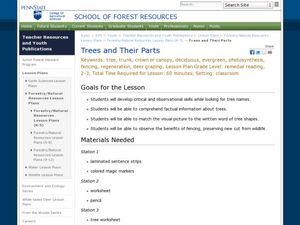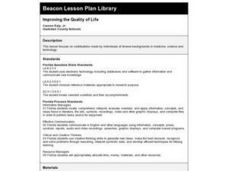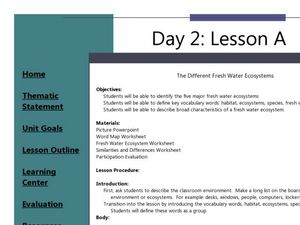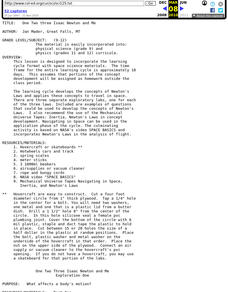Curated OER
Trees and Their Parts
Students visit five learning stations to explore various aspects of trees. They look for tree names, match visual pictures to the written words of tree shapes, and observe the benefits of fencing and preserving new cut from wildlife.
Curated OER
Marvelous Magnets
Students identify and classify magnetic and nonmagnetic materials and metals. After determining which materials and metals are magnetic, students create a data table and classify items by two different criteria. Students e-mail various...
Curated OER
Improving the Quality of Life
Students examine the contributions to medicine, science, and technology by individuals of diverse backgrounds.
Curated OER
Digital Plants...Alike and Different!
Third graders. in groups, take pictures of plants and turn them into a learning game.
Curated OER
Work Made Easy
Second graders maneuver placement of the fulcrum on the lever to see how to lift weight most easily. They role-play as archaeologists with the task of lifting a heavy rock from the dig site. They write in science journals about what...
Curated OER
The Different Fresh Water Ecosystems
Young scholars summarize the characteristics of an ecosystem. In this biology instructional activity, students identify five major fresh water ecosystem. They define terms and write a journal about what they learned.
Curated OER
Space Science:Wherever You Go, There You Are
Students explore navigation principles by observing, measuring, and interpreting data to determine locations. Using a compass, compass rose, and a transit, they plot courses and discover the workings of the Global Positioning System...
Curated OER
Learning To Look
Students examine Jacques-Louis David's Telemachus and Eucharis and Dorothea Lange's photograph of a migrant mother and consider how artists communicate ideas across time. They look closely at, and think creatively about artworks.
Curated OER
A Lottery of Learning
Young scholars investigate the probability necessary to win the lottery. They view a PowerPoint Presentation, evaluate combinations, calculate lottery probability, conduct analysis of a fair game, and design a lottery to meet various...
Curated OER
The Wetlands
Complete a comparison of the wetlands found in New York and Louisiana. Using various research methods, gather data on the wetlands found in New York and Louisiana, the animals, conditions, etc. Data is used to create a brief report on...
Curated OER
Digital Animal Presentations
First graders explore animals and digital presentations. They chose an animal and identify the physical traits of the animal. Students classify the animal using the physical traits. They create a presentation about their chosen animal.
Curated OER
Hurricanes!
Pupils access hurricane reports form the national weather service online, and draw hurricane paths. They discuss how hurricanes form and move. The research should be reported in a comprehensive presentation that can be given to a whole...
Curated OER
One, Two, Three--Isaac Newton and Me
Students experiment to develop understanding of Newton's Laws and how they apply to space travel in this ten day lesson sequence.
Curated OER
Folic Acid Health Campaign
A prewriting prompt, a class discussion, a website visit and accompanying worksheet, and a culminating group project make up this lesson on public health awareness. The topic is folic acid and how its absence in the diet may influence...
Curated OER
Classification: Dichotomous Key
Students investigate the classification process and nomenclatures used for classifying organisms. They study dichotomous keys to identify organisms with 90% accuracy. Students organize information regarding the relatedness of species.
Curated OER
What's Up With the Water Cycle?
Young scholars explore the water cycle. Students identify the stages in a water cycle and create a PowerPoint presentation based on their knowledge.
Curated OER
The 1927 Flood
Upper elementary and middle schoolers examine the Great Flood of 1927 in the state of Arkansas. They each prepare an oral report about this flood and the huge impact it had on the economics of that time. Additionally, learners research...
Curated OER
Sunburns and Sore Muscles: Working to Save the Farm During the Great Depression
Fifth through eighth graders engage in a lesson in which they study working class people during the Great Depression. They work to develop an understanding of the economic developments in Arkansas during the 1930's. Learners access...
Curated OER
Muscular Dystrophy: A Walk in Their Shoes
Health and biology learners wear five pound weights on their legs for 24 hours to simulate the extra effort required when people suffer from muscular dystrophy. They research the disability online and write about how it feels to "walk in...
Curated OER
Now You See Me, Now You Don't
Bioluminescence fascinates most upper elementary scientists. Display images of different glowing deep-sea organisms and discuss their environment. Young biologists then experiment with images and different colors of filtered light. In...
Curated OER
Sensing Energy: Designing to Stay Cool
Students examine the energy the sun produces on a daily basis. In groups, they discover the properties of visible and invisible light. They also adjust the exposure time to change the properties of various objects. To end the lesson,...
Curated OER
Brainstorming and Creating a Graphic Organizer Using Kidspiration
Although focused on the winter ecology at Crater Lake, this activity could be tweaked to use as a exploration of any region. After a visit to Crater Lake, learners discuss topics relating to winter in this area, such as the behavior of...
Curated OER
The Water Cycle - Main Components
Present the water cycle to your middle schoolers with this lesson. After an anticipatory set, they participate in a Q & A session about the terms associated with the water cycle: evaporation, transpiration, condensation, and...
Curated OER
Hurricanes
Students research the formation and life-span of hurricanes and, after analyzing statistics, try their hand at plotting and predicting the course a hurricane.

























